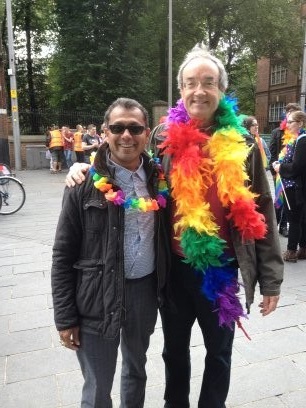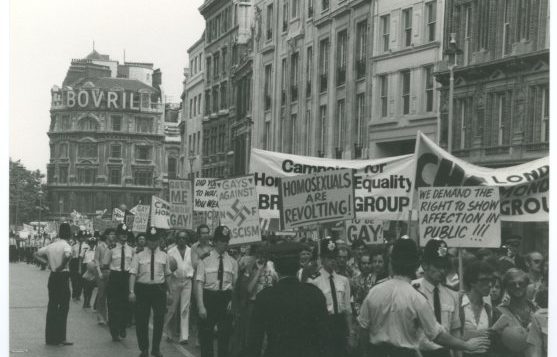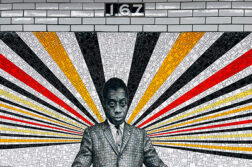
Having graduated in 1971 at the age of 22, I returned to my parents’ suburban house and decided to do something about meeting people. I had heard of the Campaign for Homosexual Equality (CHE), and somehow discovered that it had something in London called the Youth Group.
I joined the Youth Group by post and received an invitation to a meeting at a flat in Earls Court, West London. The stated age range was something like 18 to 25; the genial host struck me as middle-aged, but I see from his 2011 obituary that he must have been 34. We had a lot of parties, and I think most members had, like me, joined for social reasons.
But there was one political activity which I really enjoyed. We called it “infiltration,” and it involved going as a group to student discos and dancing together. I remember one event organizer trying to create resentment towards us by announcing that no slow music would be played. On another occasion, uniformed university employees told us very firmly to leave. My sister Marian once surprised and delighted me by offering to come with us. When she was inevitably thrown out with us, she argued assertively with the officials.
Some young gay men, particularly in London, regarded the CHE as far too middle-class and respectable: it had national officers and held conferences with motions and printed agendas. There was a more radical group called the Gay Liberation Front (GLF), inspired by activists in the U.S. I was too shy to go to their meetings, but I read their manifesto and found it inspiring. (I still have a lot of pamphlets from that era, including “With Downcast Gays” and “Towards a Quaker View of Sex”.)
In summer 1972, the GLF organized a pride march in London. My friend Tom (from the CHE group) and I decided to go. My mother, who only a few years before had been upset by my coming out, offered me materials for a banner. She gave me an old white cotton sheet, and together we raided one of my father’s sheds for poles, paint, and a brush. In the garden, I painted “Campaign for Homosexual Equality” on the sheet in proud capitals.
Tom and I went to the gathering point on the Thames Embankment by train and tube. This was the first London pride march. The GLF had managed to negotiate our use of a time-honored protest march route, involving Regent Street and Oxford Street on the way to Trafalgar Square. The police must have expected us to be attacked, because the curbs were lined with constables all along the way. Nowadays, Pride parades are seen all around the world, and the combination of loud music, whistles, and outlandish costumes is well known. But in 1972, London had never seen it before.
It was enormously exciting. Colored paper sheets were circulated, in the slightly blurred print of a Gestetner copier, bearing our chants, such as: “2, 4, 6, 8, is that copper really straight?” We also made up our own: “Out of the bank and into the streets!” While many people on the pavements looked bemused, plenty of them smiled and waved encouragingly. I did not see the police having to restrain anybody. When we got to Trafalgar Square, stirring speeches were made. No doubt Peter Tatchell was there, but I cannot remember any of the speakers. Tom and I climbed onto a ledge at the bottom of Nelson’s Column, where we were photographed holding our banner. The way we are thrusting our hips out symmetrically is amusing, but I still find that photo very moving.
In 1974, I moved to Brighton on the south coast and immediately joined the local CHE group. I also started volunteering for Brighton Gay Switchboard (initially known as Lavender Line). During the fourteen years that I lived in Brighton, I served on the committees of both organizations, including some time as “Convener” of Gay Switchboard. The switchboard title had probably been coined in the U.S., but there was a large and flourishing one in London too. It was (and remains) a phone line on which volunteers gave information and advice. At first, we were open for only two hours each evening, but as the pool of volunteers grew, we operated for longer.
As Convener, I wrote to the local press occasionally, but my main job was to organize the roster and chair meetings. Just answering the phone was a form of campaigning. People often needed to talk about whether they should come out, as well as things like the whereabouts of clubs, hotels, and other safe spaces. We sometimes received calls from people with relationship problems, and of course some callers were “hoaxers.” I cannot forget an evening after we had placed a large ad for our service in the local paper, The Brighton Evening Argus. A man who sounded like a retired colonel phoned and abused me in a most efficiently aggressive manner, specifying exactly how I should be castrated, etc., etc. Our policy was to allow such people to talk themselves to a standstill, because the likelihood was that they were gay themselves and full of self-hatred. Nevertheless, it was disturbing to listen to.
Brighton Gay Pride nowadays is a huge, commercial event that jams out the whole city center, but in the 1970s it was a small parade. We were probably just as effective when we protested over specific issues. For example, British Home Stores in Brighton sacked a man because he had appeared in a TV program about gay relationships. We picketed the shop in a central square. Some of us went into the shop and slipped leaflets into piles of clothes, saying things like: “Do you really want to buy from this shop, which discriminates against some employees?” That picket led to another disturbing experience for me, when a man shoved me and spat at me.
Another of our actions was protesting at the actor John Inman. He had a one-man show at the Dome Theatre, and we objected to his portrayal of a stereotypical, camp person, so we picketed the theatre with banners and chants.
Campaigning does not however have to be “in your face” or indeed in the street. I have been out all my adult life, particularly at work (which has involved several schools as well as universities). In the 1970s and again in the ’80s, when Thatcher introduced the appalling Section 28 of the Local Government Act (proscribing the “promotion” of homosexuality), it was important to be assertive, in a quiet and dignified manner. If asked whether I was married, for example, I used to say: “No, I am gay and live with a man.”
The London Pride event I mentioned was in 1972. Now I am aged 72 and still going strong!









Discussion2 Comments
Hello – I love this article. I would really enjoy getting in touch with David to speak further, as I am writing an article for my masters at Sussex university. I am also based in Brighton, how fun! If you see this (David) or someone from GLR has his contact details I would really appreciate it.
Lovely piece. I was on that march. I was one of the coppers (2 or 4 I think) who was really straight . Did you hear of the scuffle that took place outside the Wimpy Bar in Oxford Street? There were a couple of guys who were marching wearing Nuns kit. A couple of the Wimpy staff were Hispanic (I believe one was Mexican) anyhoo, they took exception to the “mother exteriors” and had to be dragged off (pun if you want!). It was quickly stopped by a couple of my pals. No one seriously hurt. No a bad day at all. All the best!
. Did you hear of the scuffle that took place outside the Wimpy Bar in Oxford Street? There were a couple of guys who were marching wearing Nuns kit. A couple of the Wimpy staff were Hispanic (I believe one was Mexican) anyhoo, they took exception to the “mother exteriors” and had to be dragged off (pun if you want!). It was quickly stopped by a couple of my pals. No one seriously hurt. No a bad day at all. All the best!